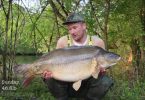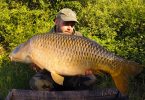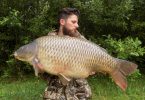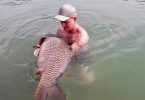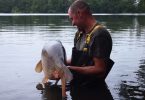By Capt. Bill Smith
At Port John Cove in British Columbia, about 20 miles from the native Indian village Bella Bella, the evening bite was on. Here Coho Salmon are measured in pounds not inches, and two weeks ago when my son Derrick and I fished, the salmon are in total feed mode as they prepare to travel up their rivers once again in September. Derrick and I were in our 18 foot center console about two miles from the mothership, a 112 foot converted tugboat named “Union Jackâ€. We were fishing the first of what would be twelve different trips over the next five fishing days in seven breathtaking locations throughout the Canadian Province. As we were about to find out, and true to the company’s slogan, we were going to “Follow the Fishâ€.
As we throttled back we set ourselves up under a sheer rock wall with trees growing on some ledges that rose straight out of the fiord to over 400 feet. Just 30 feet from its edge we were in 300 plus feet of water and even alongside it, our fish finder read 60 feet. These waterways created when the glaciers cut through British Columbia tens of thousands of years ago, now supported a rebounding salmon population in their crystal clear and bait rich waters. Bob Jacobs, the captain of Union Jack and the owner of Westwind Tugboat Adventures along with his wife Cathy who was the boats hostess had fished this area off and on for over 30 years. First as a commercial angler, and then when his conscience and overfishing got the best of him, as a sportie for the last 20 years. His company, now with two tug/yachts is the only one of its type in British Columbia, and truly offers its guests not only a unique fishing experience, but in a first class manner complete with private onboard chef, fish guides, more then comfortable staterooms and your own outboard powered skiff for the duration of the trip, complete with first rate tackle and electronics.
After a quick but very informative class in “Moochingâ€, the angling technique we’d use for the next five days Derrick and I felt confident enough to go it alone the first time while two of the other six anglers, Charlie and Earl, rode along with Rick Jakimchuk the fish guide who at twenty seven was already an experienced and seasoned angler. We put our herring baits and four ounce sinkers in the water, and set the baits at 25 and 30 “pullsâ€. A pull being one good arms length stripping of the reel, or about a foot. Derrick then nudged the boats Honda outboard in and out of gear, and watched the lines lift and drop, the herring baits on the hook end spinning in the process, flashing their silver undersides as they imitated a wounded herring. We did this for over thirty minutes; the entire time drinking in the natural and untouched beauty around us that was so vast, it at times seemed to peacefully swallow us up in its serenity.
Then suddenly Derrick’s rod started to jerk, and as instructed he fed the hungry salmon two more ‘pulls†of line as he simultaneously carefully lifted the rod from its holder and slowly began to reel, all the time waiting for the smallest amount of restriction on the line, which would signal a fish with the herring in its mouth. When he felt this after three turns of the reel, he expertly lifted the rods tip, setting the barbless hook, and increased his reeling pressure. Then when the Coho felt Derrick at the other end, it took off like a startled bluefish, peeling line off the dragless reel, and causing it to reverse, its handles spinning very fast in the process. “This is why they call it a knuckle busterâ€, Rick had demonstrated earlier in our seminar, and true to form, Derrick palmed the reel to add what drag he could, without bruising his knuckles and fingers. This went on for about fifteen minutes, as the Coho jumped, dove, ran, and skirted across the waters surface, trying top free itself from the barbless hooks, all the time having the advantage. Finally exhausted, the odds switched to Derrick’s favor and he brought the beautiful fish regal in its silver, green and red iridescence, to the net I was holding under the waters surface. After a scooping motion I’d perfected on fluke, the beautiful Coho was in the boat and was quickly verified at 17 pounds, not a world record, but for a fourteen year old boy, a fish of a lifetime, especially for his first salmon. I made the reluctant hero (in my eyes) hold the fish and pose for the usual photos in the back of the boat, as the ever proud father I am snapped away, with teary eyes. It was truly a moment frozen in time for us both, and one I knew we’d look back on with our own unique perspectives forever.
The British Columbia salmon is truly a success story. Once seemingly countless natives of over 1800 rivers in British Columbia, that number dropped almost 75 percent as commercial fishing went unchecked for decades. Then in an agreement that both commercial and recreational interests as well as British Columbia natives, signed off on, the quotas and licenses were reduced dramatically. The result has been a robust rebound in salmon stocks in just about a decade, with more and more rivers each season new homes to returning stocks. In fact today of the 1800 rivers that once hosted native fish, biologists know of over 900 supporting the fall spawn, and this number grows each year. Of course this success story, like most others has another side, the farmed salmon. This controversial fishery can when practiced responsibly serve a very valuable food purpose, but in its recent growth explosion, and resulting frenzy to profit from it, both our environment and the fish themselves have been compromised. This due to excessive nitrogen loading which damages the ecosystem, and escaping farmed fish, genetically inferior to the wild salmon, but which nevertheless breed with them. The jury is still out on this but ramifications of genetically inferior wild fish are a great concern. Back at the boat that night, Rick’s instruction clearly had made a difference as seventeen other salmon were brought in for what we were told was an exceptional first catch, all less than Derrick’s 17 pound fish though.
This went on for the next five days as we fished early in the morning after the ships generator and the boats unofficial alarm started at 6am. We rise, eat a hearty “continental breakfast†that would fill a lumberjack, prepared by the ships gourmet chef, then fish for three to four hours before returning to the mothership. On returning they’d be the inevitable fishing chatter, interrupted by the galley bell – then a three course “brunch†was served made up of plates of sausages, bacon, eggs, homemade bread, hot coffee, fresh fruit and juices, other meats and at times – fresh salmon. Afterwards, we’d dress again in our fishing gear, board our boats, now again full of bait, tackle checked, and motors running, and head out for another four or so hours of non stop fishing action. Then back to the mothership about 4:30 or 5 for cocktails and snacks as we all sat in the huge paneled salon swapping more fishing stories. Once again the fish stories would be interrupted by the gallery’s bell and we were forced to return to the big table for a dinner that would do a gladiator party proud. A few of the main course listings we enjoyed were pork loins stuffed with cranberry stuffing, prime rib, steaks and fresh pistachio crusted salmon. Not to be outdone by the shore dinner we had one night of freshly caught Dungeness crabs and freshly dug British Columbia little neck clams, the previous day by all of us, that were the sweetest clams I’ve ever tasted. Again all served with abundant fresh vegetables and fruit and washed down with lots of wine. You couldn’t loose even if the fishing was lousy!
After dinner the choices again were difficult. Either stay onboard, freshen up, socialize, and return to your stateroom to recharge for tomorrow, or fish again for about two hours before turning in. Derrick and I inevitably choose the latter, jumping in our again ready skiffs and heading out to soak in more scenery and try our hand at the fishing. We got to be pretty good at catching the salmon over the five days limiting out the fourth day, although we lost easily twice as many off the barbless hooks as we caught, which only added to the overall excitement.
In between fishing, we traveled into and through some of the mostly beautiful scenery I’ve ever seen. We watched humpback whales feeding on huge schools of krill, spotted the comical and friendly seals feeding along side us on salmon, and watched about a dozen bald eagles soar through the trees along side us. We also spotted one bald eagle trying to lift a big salmon from the water in its talons, only to give up to its weight, and swim it to shore, where in awe, we watched from the boat for over ten minutes as it, then another fed on it leaving the carcass for a bear. We also stopped in the old cannery village of Namu., the one where the first Orca whale was captured for captivity. Here a once prosperous salmon canning operation lasted for over sixty years, before it too feel victim to overfishing, rising costs, and the controversial farmed salmon. Today it is home year-round to a family of four, who are its caretakers. The parents have home schooled their children there for five years now in the isolated winters and off-season, while summers bring cruising yachts and fishing boats of all types with news, goods and conversation. It is truly a magical place with an uncertain future, but one we all left hoping would stay as it is. Here we spent an afternoon hiking to a five acre lake, and then exploring the countless little islands along the rocky shoreline, where we spotted a stellar sea lion.
Before we knew it, the five days of fishing and sightseeing were coming to an end, and we were leaving beautiful Fancy Cove our final layover spot about 10am and motoring back towards Bella Bella where the plane would take the eight of us back to Vancouver and then our separate ways. After some final socializing, and exchanging of addresses and emails with the crew and other guests, I spent a good part of the trip back up in the wheel house with Bob and Catchy as we spoke about their 20 year history with this beautiful ship taking people fishing, the history of the area, what we hoped would be its future, and of course it’s beauty. It once again was confirmed to me that they both truly love what they do, and it shows in their words and work. When we arrived at the dock in Bella Bella, we all posed for a group photograph before saying our good byes, and again my eyes teared up as I hugged Cathy and shook Bob’s hand, saying goodbye to two people who in a short time had not only given Derrick and I memories to carry forever, but equally as important who had become our friends. As I climbed into the van that would take us to the airport, I saw two others wiping their eyes, and knew what I’d suspected, that their lives too as well as the rest, would now be a little better because of the past magical week.
Capt. Bill Smith – 2004



